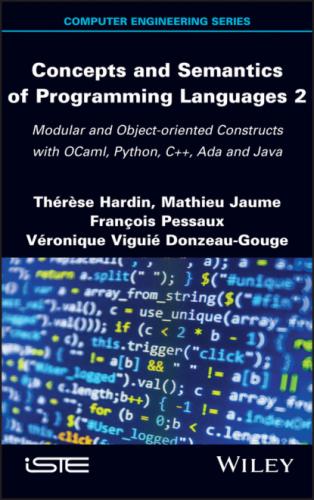246 242
247 243
248 244
249 245
250 246
251 247
252 248
Series Editor
Jean-Charles Pomerol
Concepts and Semantics of Programming Languages 2
Modular and Object-oriented Constructs with OCaml, Python, C++, Ada and Java
Thérèse Hardin
Mathieu Jaume
François Pessaux
Véronique Viguié Donzeau-Gouge
First published 2021 in Great Britain and the United States by ISTE Ltd and John Wiley & Sons, Inc.
Apart from any fair dealing for the purposes of research or private study, or criticism or review, as permitted under the Copyright, Designs and Patents Act 1988, this publication may only be reproduced, stored or transmitted, in any form or by any means, with the prior permission in writing of the publishers, or in the case of reprographic reproduction in accordance with the terms and licenses issued by the CLA. Enquiries concerning reproduction outside these terms should be sent to the publishers at the undermentioned address:
ISTE Ltd
27-37 St George’s Road
London SW19 4EU
UK
John Wiley & Sons, Inc.
111 River Street
Hoboken, NJ 07030
USA
© ISTE Ltd 2021
The rights of Thérèse Hardin, Mathieu Jaume, François Pessaux and Véronique Viguié Donzeau-Gouge to be identified as the authors of this work have been asserted by them in accordance with the Copyright, Designs and Patents Act 1988.
Library of Congress Control Number: 2021935827
British Library Cataloguing-in-Publication Data
A CIP record for this book is available from the British Library
ISBN 978-1-78630-602-9
Foreword
Computer programs have played an increasingly central role in our lives since the 1940s, and the quality of these programs has thus become a crucial question. Writing a high-quality program – a program that performs the required task and is efficient, robust, easy to modify, easy to extend, etc. – is an intellectually challenging task, requiring the use of rigorous development methods. First and foremost, however, the creation of such a program is dependent on an in-depth knowledge of the programming language used, its syntax and, crucially, its semantics, i.e. what happens when a program is executed.
The description of this semantics puts the most fundamental concepts into light, including those of value, reference, exception or object. These concepts are the foundations of programming language theory. Mastering these concepts is what sets experienced programmers apart from beginners. Certain concepts – like that of value – are common to all programming languages; others – such as the notion of functions – operate differently in different languages; finally, other concepts – such as that of objects – only exist in certain languages. Computer scientists often refer to “programming paradigms” to consider sets of concepts shared by a family of languages, which imply a certain programming style: imperative, functional, object-oriented, logical, concurrent, etc. Nevertheless, an understanding of the concepts themselves is essential, as several paradigms may be interwoven within the same language.
Introductory texts on programming in any given language are not difficult to find, and a number of published books address the fundamental concepts of language semantics. Much rarer are those, like the present volume, which establish and examine the links between concepts and their implementation in languages used by programmers on a daily basis, such as C, C++, Ada, Java, OCaml and Python. The authors provide a wealth of examples in these languages, illustrating and giving life to the notions that they present. They propose general models, such as the kit presented in Volume 2, permitting a unified view of different notions; this makes it easier for readers to understand the constructs used in popular programming languages and facilitates comparison. This thorough and detailed work provides readers with an understanding of these notions and, above all, an understanding of the ways of using the latter to create high-quality programs, building a safer and more reliable future in computing.
Gilles DOWEK
Research Director, Inria
Professor at the École normale supérieure, Paris-Saclay
Catherine DUBOIS
Professor at the École nationale supérieure d’informatique pour l’industrie et l’entreprise
January 2021
Preface
This two-volume work relates to the field of programming. First and foremost, it is intended to give readers a solid grounding in the bases of functional or imperative programming, along with a thorough knowledge of the module and class mechanisms involved. In our view, the semantics approach is most appropriate when studying programming, as the impact of interlanguage syntax differences is limited. Practical considerations, determined by the material characteristics of computers and/or “smart” devices, will also be addressed. The same approach will be taken in both volumes, using both mathematical formulas and memory state diagrams. With this book, we hope to help readers understand the meaning of the constructs described in the reference manuals of programming languages and to establish solid foundations for reasoning and assessing the correctness of their own programs through critical review. In short, our aim is to facilitate the development of safe and reliable software programs.
Volume 1 presented a broad overview of the functional and imperative features of programming, from notions that can be modeled mathematically to notions that are linked to the hardware configuration of computers themselves.
Volume 2 is dedicated to the study of language features (modules, classes, objects) that are known to ease the development of software systems. It builds on the foundations laid down in Volume 1 since modules, classes and objects are, in essence, the means of organizing functional or imperative constructs.
Chapter 1 first analyzes some of the needs of developers in terms of tools for building large software. Based on these requirements, an original semantic model is drawn up, jointly presenting all of the features of modules and classes that can meet these needs. We introduce our own structure, a kit, to describe this model, a word chosen to avoid any confusion with the usual denominations (structure, module, package, class, etc.) used by languages. These kits serve to explain naming management, export and import mechanisms, access restrictions, extension and parametrization (genericity, functors),
